Myoung
Ho Lee (b. 1975) has pursued profound explorations of art through the medium of
photography, revealing and evoking reality or creating unreality, thus delving
into the representation and reenactment of images. To this end, he has been
developing the ‘Photography-Act Project,’ fostering discourse on photographic
art while offering unique artistic experiences.
 Myoung
Ho Lee, Tree…#1,
2007 ©Gallery Hyundai
Myoung
Ho Lee, Tree…#1,
2007 ©Gallery HyundaiSince
2004, Myung Ho Lee has been continuing his ‘Photography-Act Project,’ a
photographic exploration that reflects his reverence for nature and his inquiry
into the representation and reenactment of images. The first work in this
project, and his iconic piece, is the Tree series. In this
series, Lee stages a white canvas behind trees, isolating the subject from its
original natural context.
Positioning
a background screen behind the subject is reminiscent of the long-standing
tradition of studio photography. At the same time, the resulting photographic
images evoke the still-life paintings of Western art. By flattening a tree—once
an integral part of the vast natural landscape—into a two-dimensional image
framed on a canvas, the work highlights the tree as an independent subject,
distinct from its surroundings.
 Myoung
Ho Lee, Tree…#2,
2007 ©Gallery Hyundai
Myoung
Ho Lee, Tree…#2,
2007 ©Gallery HyundaiThe
‘Photography-Act Project’ diverges from traditional landscape or still-life
photography by transforming the subject into a seemingly reproduced image
through the use of a canvas. This approach introduces a new dimension to the
issue of photographic representation by redefining reality through simple
installation acts without altering the original form or essence of the subject.
In doing so, Lee endows the subject with individuality, offering a fresh
perspective on the relationship between reality and representation in photography.
 Myoung Ho
Lee, Mirage #1_Gobi, 2009 ©Myoung Ho Lee
Myoung Ho
Lee, Mirage #1_Gobi, 2009 ©Myoung Ho LeeIf
the Tree series, Lee's first ‘Photography-Act Project,’
introduced a new perspective on the "representation" of photography,
the subsequent Mirage series fosters discourse on the
"reenactment" aspect of art.
Similar
to the Tree series, the Mirage series
involves setting up a white canvas in a natural setting. However, unlike the Tree
series, which reveals reality, the Mirage series transforms
one reality into another

Myoung Ho Lee, Mirage #4_Silk Road, 2011 ©Gallery Hyundai
In
this series, Lee installs a large white fabric in a barren desert and
photographs it from a distance, creating the illusion of a shimmering sea or
oasis in the distance. Here, the white canvas functions as a device of illusory
simulacrum, exposing the fictional within the real.
 Myoung
Ho Lee, Heritage
#3_Seojangdae, 2015
©Gallery Hyundai
Myoung
Ho Lee, Heritage
#3_Seojangdae, 2015
©Gallery HyundaiMyoung
Ho Lee, who focused solely on capturing natural subjects in his Photography-Act
Project series Tree and Mirage, began
including artificial structures as subjects starting with the Heritage
series.
Heritage
#3_Seojangdae (2014) was commissioned to commemorate the AICA
(International Association of Art Critics) General Assembly held in Suwon and
features Seojangdae, a historic pavilion in Suwon Hwaseong Fortress, as its
subject. By positioning a white canvas behind Seojangdae, the artist
meticulously highlighted the structure’s unique architectural form, emphasizing
its historical and cultural significance.
Since
being appointed an ambassador for the National Research Institute of Cultural
Heritage in 2018, Lee has continued to spotlight the value and presence of
cultural heritage through his works, focusing on historical sites across
various regions.
 Myoung
Ho Lee, Nothing
But #1, 2017
©Gallery Hyundai
Myoung
Ho Lee, Nothing
But #1, 2017
©Gallery HyundaiIn
his 2018 solo exhibition “Nothing, But” at Gallery Hyundai, Myoung Ho Lee
unveiled Nothing But, the third series in his ‘Photography-Act
Project.’ While his earlier works utilized the white canvas as a device for
representation or reenactment, in Nothing But, the canvas is
simply placed within nature, detached from any role of revealing or creating.
 Myoung
Ho Lee, Nothing
But #2, 2018
©Gallery Hyundai
Myoung
Ho Lee, Nothing
But #2, 2018
©Gallery HyundaiHaving
relinquished the function of revealing or creating something, the canvas
encompasses everything precisely because it does not offer anything in
specific. Through this act of emptiness, it embodies infinite potential.
Nothing
But resides between or beyond representation and reenactment,
infinitely expanding Lee’s artistic pursuit of the traces of existence and the
essence of reality.
 Myoung
Ho Lee, 9
Minutes' Layers #1, 2018
©Gallery Hyundai
Myoung
Ho Lee, 9
Minutes' Layers #1, 2018
©Gallery HyundaiSimilar
to Nothing But, the 9 Minutes' Layers
(2018) series features a blank white surface, reflecting the artist's
simultaneous desire and futility in owning and collecting images. At first
glance, the work appears to display an empty white sheet enclosed within a
frame. However, upon closer inspection, faint traces of prints can be discerned
within.
To
create these images, the artist captured ten photographs over nine minutes at
one-minute intervals, then layered them in Photoshop, blending the three
primary colors of light—red, green, and blue. This process results in an image
where all forms seem to vanish, leaving only white. Through this work, Lee
highlights the paradox of photography as an act of capturing light: the more
light is accumulated, the more everything ultimately disappears, revealing the
transient and elusive nature of the medium as a ‘Photography-Act.’
 Myoung
Ho Lee, Tree
& Color_Changwon #1, 2020
©Changwon Sculpture Biennale
Myoung
Ho Lee, Tree
& Color_Changwon #1, 2020
©Changwon Sculpture BiennaleIn
2020, Myoung Ho Lee participated in the Changwon Sculpture Biennale, presenting
an installation project that extended his ongoing ‘Photography-Act Project.’ Tree
& Color_Changwon #1 (2020) shares the foundational structure of
his earlier Tree series, where a canvas is set up behind a
tree. However, this work evolves into a variable and long-term project in which
the size of the canvas will be expanded every five years, reflecting the tree's
natural growth.
Unlike
previous works that used a white canvas, Tree & Color_Changwon #1
features a steel plate coated with holographic paint. This material interacts
with shifting light and the movements of viewers, not only altering the
appearance of the tree but also transforming the reflections of the surrounding
landscape on the surface.

Myoung Ho Lee, [drənæda]_Island #1, 2020 ©Goeun Museum of Photography
The
[drənæna] (2020) series, presented the same year,
explores the dual processes of "revealing" (making visible) and
"removing" (making disappear), contrasting with Myoung Ho Lee’s
earlier works centered on "revelation" through photography.
Inspired
by the homophones "드러내다" (to reveal) and "들어내다" (to
remove), which share similar pronunciations—represented phonetically as [drənæna]—Lee
developed this project to delve into these contrasting meanings. To execute the
work, the artist first prints a photograph on paper, revealing the image. He
then meticulously removes the thin layer of ink on the surface using a surgical
scalpel and magnifying glass.
These
works can be understood as both "removing" the image, in the sense of
erasing it, and as "revealing" the hidden essence of the image beyond
a single layer of surface, leaving room for a dual interpretation.
 Myoung
Ho Lee, Tree…
#10, 2017
©Gallery Hyundai
Myoung
Ho Lee, Tree…
#10, 2017
©Gallery HyundaiLee Myung-ho says that the essence of art lies in revealing a corner of the world. His decade-long ‘Photography-Act Project’ has involved revealing reality, creating the unreal, and addressing what lies beyond, capturing a series of processes that demonstrate the role of art through the medium of photography. And his poetic yet philosophical photographic images make the familiar seem strange, prompting viewers to see everyday life from a new perspective.
“By
placing a small canvas behind petty things, I reveal them buried in nature. While
what I only do is placing the canvas behind such things instead of drawing
them, it has the original meaning of artistic activities.
My childhood dream was
to be a postman who delivers the letter of this person to that person. I
thought that, even if it is the simplest and the pettiest work, it is also the
most fruitful and suitable to me. Art is another form of the dream. To me, art
is to reveal a corner of the world and remind it to people, and objectify
reason and emotion and deliver them to people.

Artist Myoung Ho Lee ©Newspost
Myung
Ho Lee
majored in photography at Chung-Ang University and its graduate school. He has
established a strong presence, receiving awards such as the Photo Critic Award
(The Committee of Photo Critic Award, 2006) and the Artist of Tomorrow (Sungkok
Art Museum, 2009). He has held solo exhibitions at major institutions both in
Korea and internationally, including Yossi Milo Gallery (New York, 2009/2017),
Sungkok Art Museum (Seoul, 2010), Gallery Hyundai (Seoul, 2013/2018), and Savina
Museum (Seoul, 2017).
Lee
has exhibited most recently at the Hayward Gallery Southbank Centre (2020), the
J. Paul Getty Museum (2019), Kunst Haus Wien (2017), National Gallery of
Victoria (2017), and Seoul Museum of Art (2016). His works are included in
renowned collections including Bibliothèque Nationale de France, J. Paul Getty
Museum, Fotografiemuseum Amsterdam, National Gallery of Victoria, Museo Arte
Contemporáneo Salta, National Museum of Modern and Contemporary Art Korea, and
Seoul Museum of Art.
References
- 갤러리현대, 이명호 (Gallery Hyundai, Myoung Ho Lee)
- 국립현대미술관, 이명호 | 나무 2 | 2007 (National Museum of Modern and Contemporary Art Korea, Myoung Ho Lee | Tree 2 | 2007)
- 경향신문, 아무것도 없는 캔버스, 작가가 의도한 건?, 2018.12.19
- 갤러리현대(Gallery Hyundai), Myoung Ho Lee 이명호 : Art Billboard Project
- 2020 창원조각비엔날레, 이명호 (2020 Changwon Sculpture Biennale, Myoung Ho Lee)
- 경향신문, 캔버스를 앞으로, 뒤로, 밑으로···이명호가 사진에 ‘개입’하는 법, 2018.12.10
- 고은사진미술관, 이명호 [드러내다] (Goeun Museum of Photography, Myoung Ho Lee [drənæna])
- 금강자연미술비엔날레 2020, 이명호 (Geumgang Nature Art Biennale 2020, Myoung Ho Lee)


















